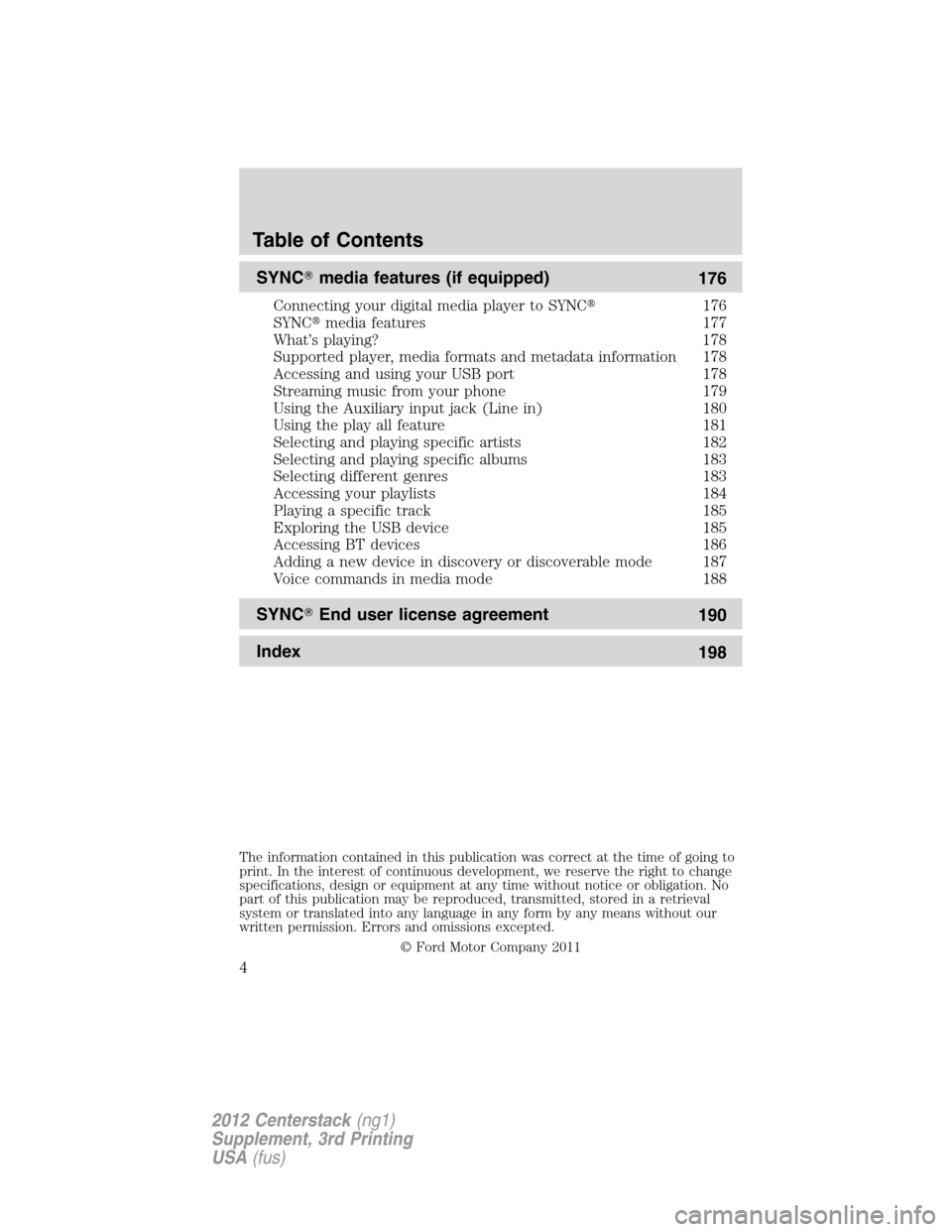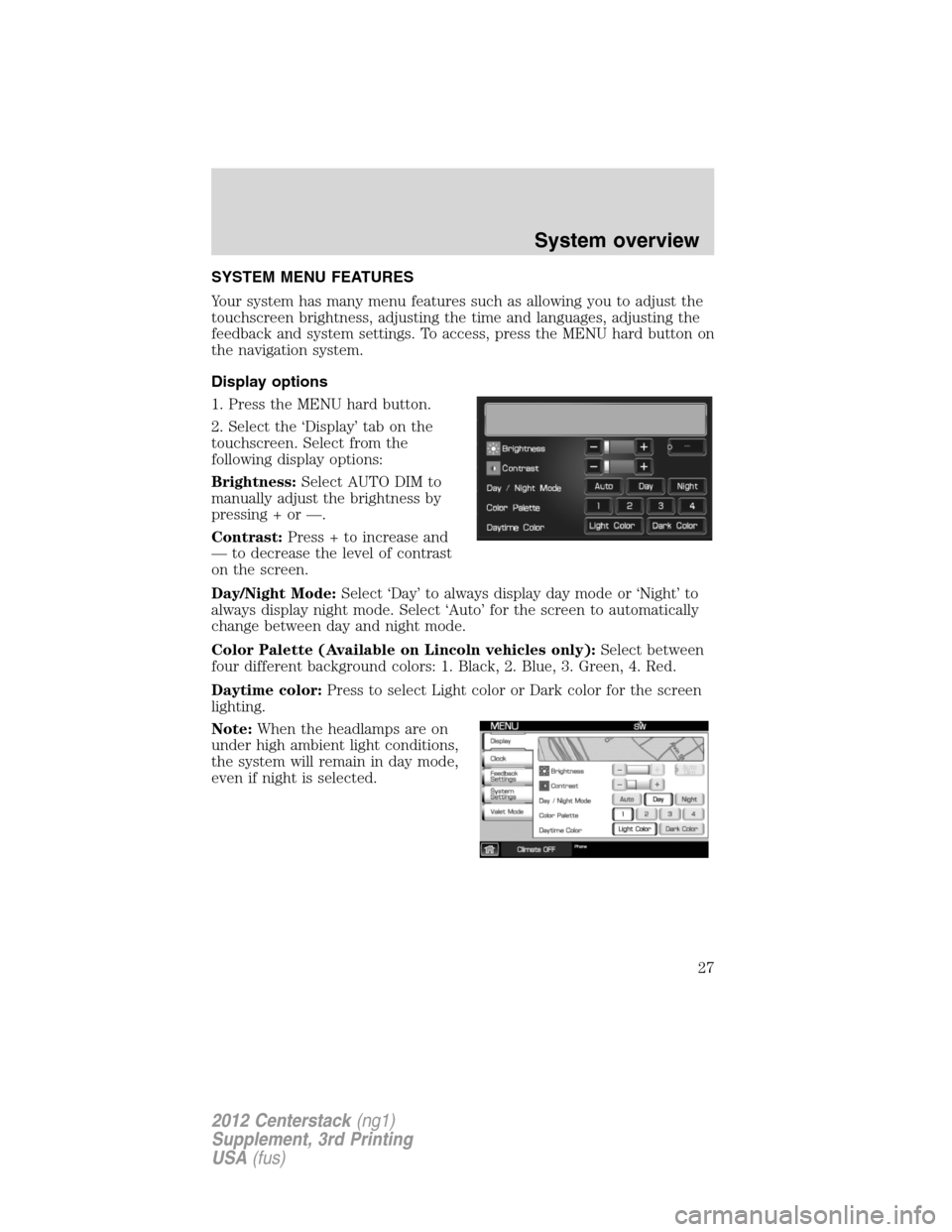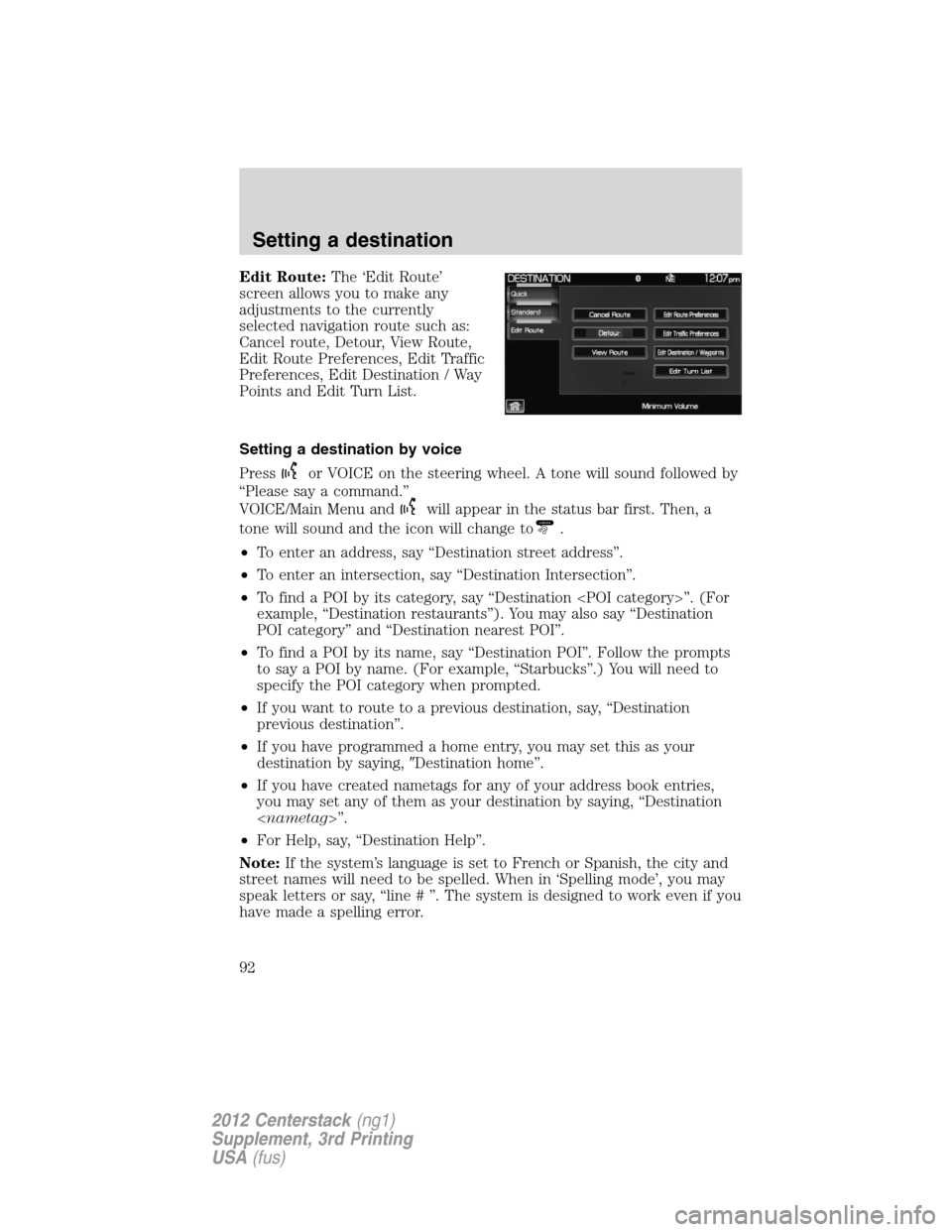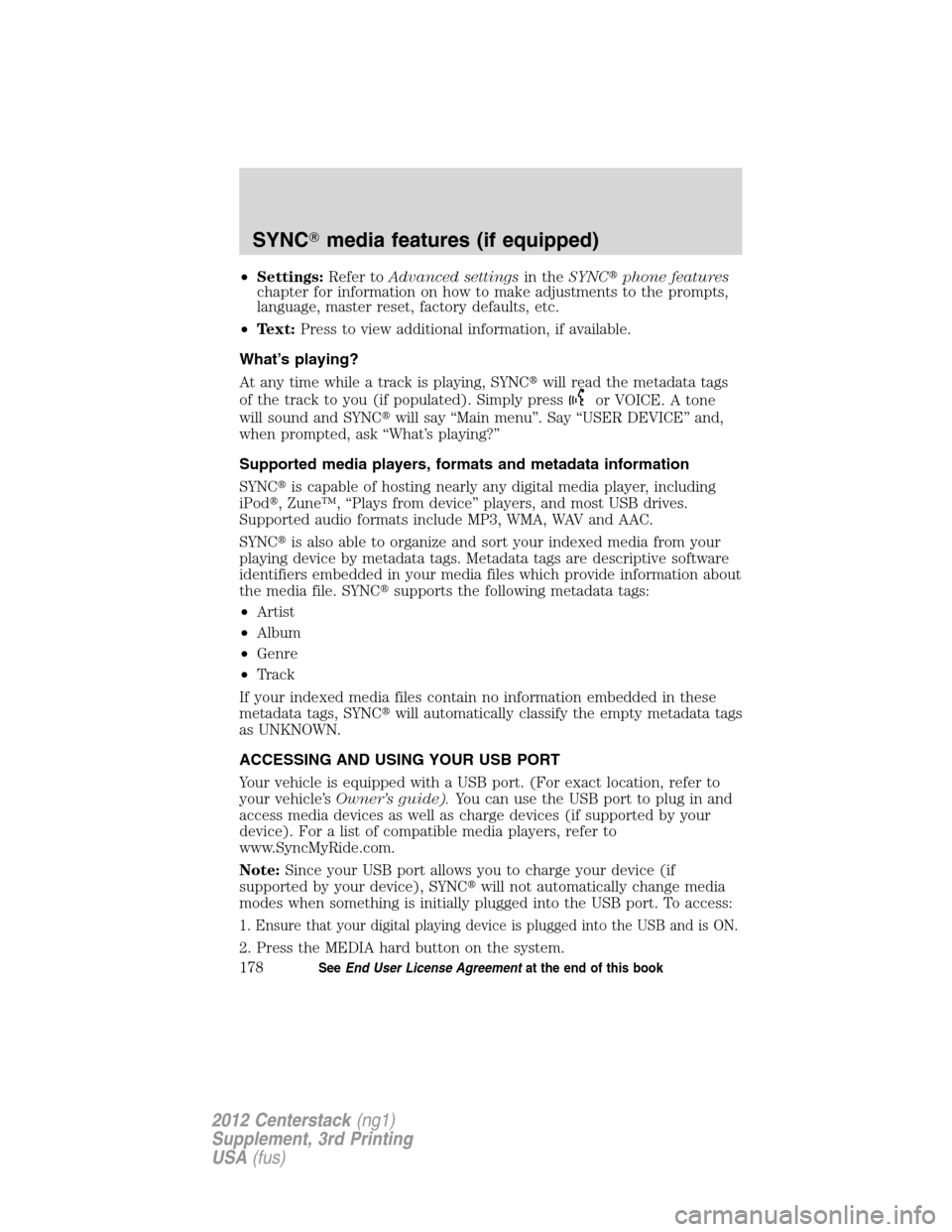Page 4 of 200

SYNC�media features (if equipped)
176
Connecting your digital media player to SYNC�176
SYNC�media features 177
What’s playing? 178
Supported player, media formats and metadata information 178
Accessing and using your USB port 178
Streaming music from your phone 179
Using the Auxiliary input jack (Line in) 180
Using the play all feature 181
Selecting and playing specific artists 182
Selecting and playing specific albums 183
Selecting different genres 183
Accessing your playlists 184
Playing a specific track 185
Exploring the USB device 185
Accessing BT devices 186
Adding a new device in discovery or discoverable mode 187
Voice commands in media mode 188
SYNC�End user license agreement
190
Index
198
The information contained in this publication was correct at the time of going to
print. In the interest of continuous development, we reserve the right to change
specifications, design or equipment at any time without notice or obligation. No
part of this publication may be reproduced, transmitted, stored in a retrieval
system or translated into any language in any form by any means without our
written permission. Errors and omissions excepted.
© Ford Motor Company 2011
Table of Contents
4
2012 Centerstack(ng1)
Supplement, 3rd Printing
USA(fus)
Page 27 of 200

SYSTEM MENU FEATURES
Your system has many menu features such as allowing you to adjust the
touchscreen brightness, adjusting the time and languages, adjusting the
feedback and system settings. To access, press the MENU hard button on
the navigation system.
Display options
1. Press the MENU hard button.
2. Select the ‘Display’ tab on the
touchscreen. Select from the
following display options:
Brightness:Select AUTO DIM to
manually adjust the brightness by
pressing + or —.
Contrast:Press + to increase and
— to decrease the level of contrast
on the screen.
Day/Night Mode:Select ‘Day’ to always display day mode or ‘Night’ to
always display night mode. Select ‘Auto’ for the screen to automatically
change between day and night mode.
Color Palette (Available on Lincoln vehicles only):Select between
four different background colors: 1. Black, 2. Blue, 3. Green, 4. Red.
Daytime color:Press to select Light color or Dark color for the screen
lighting.
Note:When the headlamps are on
under high ambient light conditions,
the system will remain in day mode,
even if night is selected.
System overview
27
2012 Centerstack(ng1)
Supplement, 3rd Printing
USA(fus)
Page 92 of 200

Edit Route:The ‘Edit Route’
screen allows you to make any
adjustments to the currently
selected navigation route such as:
Cancel route, Detour, View Route,
Edit Route Preferences, Edit Traffic
Preferences, Edit Destination / Way
Points and Edit Turn List.
Setting a destination by voice
Press
or VOICE on the steering wheel. A tone will sound followed by
“Please say a command.”
VOICE/Main Menu and
will appear in the status bar first. Then, a
tone will sound and the icon will change toListening.
•To enter an address, say “Destination street address”.
•To enter an intersection, say “Destination Intersection”.
•To find a POI by its category, say “Destination ”. (For
example, “Destination restaurants”). You may also say “Destination
POI category” and “Destination nearest POI”.
•To find a POI by its name, say “Destination POI”. Follow the prompts
to say a POI by name. (For example, “Starbucks”.) You will need to
specify the POI category when prompted.
•If you want to route to a previous destination, say, “Destination
previous destination”.
•If you have programmed a home entry, you may set this as your
destination by saying,�Destination home”.
•If you have created nametags for any of your address book entries,
you may set any of them as your destination by saying, “Destination
”.
•For Help, say, “Destination Help”.
Note:If the system’s language is set to French or Spanish, the city and
street names will need to be spelled. When in ‘Spelling mode’, you may
speak letters or say, “line # ”. The system is designed to work even if you
have made a spelling error.
Setting a destination
92
2012 Centerstack(ng1)
Supplement, 3rd Printing
USA(fus)
Page 178 of 200

•Settings:Refer toAdvanced settingsin theSYNC�phone features
chapter for information on how to make adjustments to the prompts,
language, master reset, factory defaults, etc.
•Text:Press to view additional information, if available.
What’s playing?
At any time while a track is playing, SYNC�will read the metadata tags
of the track to you (if populated). Simply press
or VOICE. A tone
will sound and SYNC�will say “Main menu”. Say “USER DEVICE” and,
when prompted, ask “What’s playing?”
Supported media players, formats and metadata information
SYNC�is capable of hosting nearly any digital media player, including
iPod�, Zune™, “Plays from device” players, and most USB drives.
Supported audio formats include MP3, WMA, WAV and AAC.
SYNC�is also able to organize and sort your indexed media from your
playing device by metadata tags. Metadata tags are descriptive software
identifiers embedded in your media files which provide information about
the media file. SYNC�supports the following metadata tags:
•Artist
•Album
•Genre
•Track
If your indexed media files contain no information embedded in these
metadata tags, SYNC�will automatically classify the empty metadata tags
as UNKNOWN.
ACCESSING AND USING YOUR USB PORT
Your vehicle is equipped with a USB port. (For exact location, refer to
your vehicle’sOwner’s guide).You can use the USB port to plug in and
access media devices as well as charge devices (if supported by your
device). For a list of compatible media players, refer to
www.SyncMyRide.com.
Note:Since your USB port allows you to charge your device (if
supported by your device), SYNC�will not automatically change media
modes when something is initially plugged into the USB port. To access:
1. Ensure that your digital playing device is plugged into the USB and is ON.
2. Press the MEDIA hard button on the system.
SYNC�media features (if equipped)
178SeeEnd User License Agreementat the end of this book
2012 Centerstack(ng1)
Supplement, 3rd Printing
USA(fus)